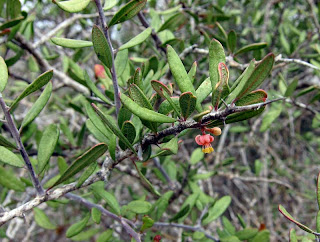 |
| "Galapagos" Magnificent Frigatebird - a potential split in the works |
Since I last posted photos only from the first two days of my Galapagos Tour and just a couple days ago learned that WINGS will be offering the same tour this coming November, it's about time to post the rest of my photo highlights.
One reason for our offering this same itinerary in a somewhat "last minute" fashion (still 11 months away, actually) is that the Galapagos National Park will be instituting their new rules in January 2012 – limiting boats one visit every 2 weeks on each island. This means that a itinerary suited to birders wanting to see most of the endemics would require a boat to offer a comprehensive, attractive itinerary one week, and an itinerary of dregs in the second week. As far as we can tell, most boats, including the fabulous Integrity, are choosing to offer instead alternating weeks of attractive itineraries that each visit half of the most bird-rich islands.
So unless things change, 2011 may be your last chance to see the bulk of the Galapagos Island endemics and specialties in a single week's cruise. After that you'll have to choose between a week offering Waved Albatrosses and boobies or another week to see Penguins, Medium Tree-Finch and Cormorants. (Though a Galapagos Penguin or two might be possible on the first week as well.)
This was our day on the island of Floreana and nearby islets (such as Champion, where we saw the Floreana Mockingbird and did some fabulous snorkeling). Birds weren't as diverse or easy to photograph today, but it was an interesting day botanically.
We began the morning at Punta Cormorant, surveying the beach which hosted a Whimbrel, a Black-bellied Plover, a Wandering Tattler, and Least Sandpipers.
At Punta Comorant (named after a boat, it seems, not the bird) we admired this lone (and fragrant) Black Mangrove, Avicennia germinans. There are several species of trees called mangroves, but they are not even closely related to each other – they only share the general ecological niche of shallow saltwater. Black Mangrove is the only one in the verbena family, and this flower certainly looks the part.
This is Galapagos Bitterbush, Castela galapageia, in the tropical Quassia family Simaroubaceae.
Members of the family Asteraceae, known as composites, must have been among the first plants to colonize the Galapagos, as they have diversified tremendously here, many having no close mainland relatives. There are entire genera endemic to the archipelago including this Lecocarpus pinnatifidus.
This looks something like pickleweed and does indeed grow right next to the salty ocean, but is the completely unrelated Turtleweed, Batis maritima, Batidaceae
This is an unusual beach. Some people are rather unsettled by the thought, but it's really not so scary to actually slowly wade into the lapping waves and wait until the water clears...
....to see Diamond Stingrays reveal themselves right at your feet. Sometimes they touch your feet, but they won't sting unless you actually walk on them, which isn't easy to do if you wade slowly and then just stand there.
If this isn't your cup of tea, you could stay higher on the beach and watch this Semipalmated Plover and Sanderling fight over feeding territories.
Richard Polatty, the best officially licensed naturalist guide in the Galapagos, takes the post out of the box at Post Office Bay. Most all postcards are deposited by other tourists without postage. If you find one for someone near where you live, you take it home and deliver it by hand. Some people address one to themselves to see how long it takes (and meet fellow travelers). I saw one card that had been written just a week earlier by two clients who were with me in Costa Rica many years ago – Hi Mark and Libby!
Spotless Ladybug, Cyloneda sanguinea, exactly where I had seen them on previous trips here.
We then took an inland excursion to the highland interior area called Asilo de la Paz. Here were learned about the interesting history of colonization and saw the single-island endemic Medium Tree-Finch.
Another endemic genus of asteraceae Scalesia. Most members of this huge family are small plants to large shrubs; only on the Galapagos do some become as tall as trees, such as this Scalesia pedunculata.
Presumably Darwin was the first to collect species from this genus, as it was named by his good friend Joseph Dalton Hooker. And presumably Hooker named it after a Mr. Scales, as that -ia ending is added to a proper name in order to coin plant genera. (Fuchsia was named after Leonhart Fuchs, Poinsettia was named after Joel Roberts Poinsett, etc. I just haven't been able to find out who Scales was, as internet searches always turn up other uses of that common English word.) Keep this in mind when pronouncing "Scalesia," so as to keep the one-syllabled name Scales intact – please, not sca-LEE-sia, which sounds more like a disease or an obscure country north of the Caucasus.
On a totally different scale (ahem), here's the endemic Galapagos Peperomia, Peperomia galapagensis, growing as an epiphyte on a rock.
After our barbecue dinner by the beach, I noticed this moth on the walls of the building, thinking I must have yet another cool endemic. I actually recognized the genus Melipotis, but I was quite surprised to find that this is the same species that I photographed just year before last in Sycamore Canyon and at my friend Mich's house in Tucson – the Indomitable Melipotis Moth, Melipotis indomita.
























No comments:
Post a Comment